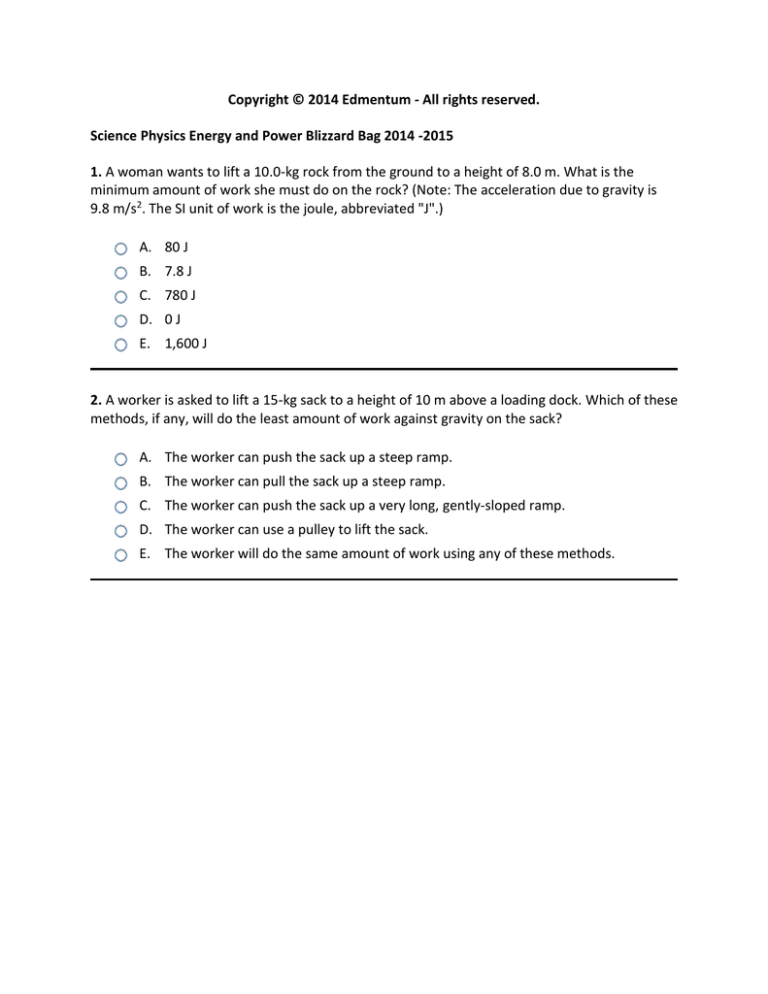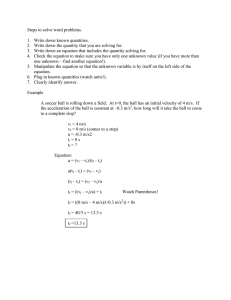
Copyright © 2014 Edmentum - All rights reserved.
Science Physics Energy and Power Blizzard Bag 2014 -2015
1. A woman wants to lift a 10.0-kg rock from the ground to a height of 8.0 m. What is the
minimum amount of work she must do on the rock? (Note: The acceleration due to gravity is
9.8 m/s2. The SI unit of work is the joule, abbreviated "J".)
A. 80 J
B. 7.8 J
C. 780 J
D. 0 J
E. 1,600 J
2. A worker is asked to lift a 15-kg sack to a height of 10 m above a loading dock. Which of these
methods, if any, will do the least amount of work against gravity on the sack?
A. The worker can push the sack up a steep ramp.
B. The worker can pull the sack up a steep ramp.
C. The worker can push the sack up a very long, gently-sloped ramp.
D. The worker can use a pulley to lift the sack.
E. The worker will do the same amount of work using any of these methods.
3.
To begin a game of billiards, the cue ball moves with velocity vc toward a group of 15 billiard
balls that are at rest. After the collision, each of the 15 billiard balls are set in motion.
What can be concluded about the motion of the billiard balls (including the cue ball)
immediately after the collision? Assume all the billiard balls have equal mass.
I. No billiard ball is moving with a velocity in the opposite direction of vc.
II. No billiard ball is moving with a velocity in the same direction as vc.
III. No billiard ball is moving with a velocity greater than the magnitude of vc.
A. I and III only
B. II and III only
C. I and II only
D. I only
E. III only
4. A lone (unattached) railroad flatbed car is coasting at constant velocity across a horizontal
track. Then, very quickly, several bales of hay are dropped onto the car from a platform above
it.
How does the speed of the flatbed car change? (Assume that the mass of the hay is significantly
large.)
A. The speed increases.
B. The speed either increases or decreases, depending on the weight of the hay.
C. The speed stays the same.
D. The speed decreases.
E. The speed either increases or decreases, depending on the change in the mass of
the flatbed car.
5. The SI unit of work is the joule (J). Which of the following equals 1 J?
A. 1 kg · m/s2
B. 1 kg · m2/s2
C. 1 N/s
D. 1 kg · m/s
E. 1 (kg · m/s)2
6. A car is moving forward with a momentum of 1,000 kg·m/s. Then, over a span of 10 seconds,
its momentum reduces at a constant rate to become 600 kg·m/s.
According to Newton's second law of motion, what must have happened to the car?
A. The mass of the car must have changed.
B. The forces on the car remained the same.
C. A net force of 40 N was applied to the car in the same direction as its motion.
D. A net force of 40 N was applied to the car in the opposite direction of its motion.
E. Forces must have stopped acting on the car.
7. John is moving a watermelon. In which example does John do the least amount of work on
the watermelon?
A. John holds the watermelon steady as he walks up a staircase.
B. John holds the watermelon steady as he walks across a flat surface.
C. John lifts the watermelon over his head.
D. John drags the watermelon behind him as he walks across a carpeted floor.
E. John rolls the watermelon across a carpeted horizontal floor.
8.
A man pulls a 25 kg sled across a flat, snowy surface. He holds the handle of the sled at an angle
of 30° with the ground and exerts a force of 27 N. How much work does he do on the sled over
a distance of 80 meters? (cos 30° = 0.87 and sin 30° = 0.5)
A. 9800 J
B. 1100 J
C. 2200 J
D. 1900 J
E. 17000 J
9. In most roller coasters, a conveyor belt or chain slowly lifts a coaster car from its resting
position to the top of the first hill. No further energy is added to the coaster car as it rolls on
tracks up and down the remaining hills.
For this type of roller coaster, which of these sections of track could be included?
I. track that drops lower than the resting point
II. track that climbs higher than the first hill
III. track that is steeper than the first hill
A. II and III only
B. I, II, and III
C. I and III only
D. III only
E. I and II only
10. A car's engine runs on gasoline. A scientist describes the engine to be about 12% efficient.
What does this mean?
A. The engine's power output is about 12% less than the power that the gasoline
provides.
B. About 12% of the power that the gasoline provides is converted into the engine's
output power.
C. The engine's power output is about 12% more than the power that the gasoline
provides.
D. About 12% of the gasoline's energy is lost to heat.
E. About 12% of the energy of the gasoline is in a form that the engine cannot use.
11.
A pendulum is made of a ball attached to the bottom of a stiff rod. The pendulum swings back
and forth between positions A and C in the diagram. Positions A and C are the highest points of
the arc, whereas position B is the lowest point of the arc.
As the pendulum swings, gravitational potential energy is converted to kinetic energy as the
ball moves __________.
A. from position C to B to A
B. toward position B from either direction
C. from position B to C
D. from position A to B to C
E. from position B to A
12. Two billiard balls have equal mass. Ball A rolls at speed 5.0 m/s and Ball B rolls at speed 8.0
m/s in the opposite direction. The two balls collide at these speeds and bounce backward in an
elastic collision.
Immediately after the collision, the speed of Ball A is _______ m/s and of Ball B is _______ m/s.
(Assume that the law of conservation of momentum applies to the two balls.)
A. 0, 13
B. 13, 0
C. 5.0, 8.0
D. 8.0, 5.0
E. 6.5, 6.5
13. A soccer ball is at rest. When a player kicks the ball, her foot applies an average forward
force of 80 N to the ball in the span of 0.50 second. The product of the average force and the
time it is applied is 40 N-s. What does this quantity indicate? (Assume that friction and all other
forces that may act on the soccer ball are negligible)
I. the impulse of the force on the soccer ball
II. the change in momentum of the soccer ball
III. the change in kinetic energy of the soccer ball
A. I and II only
B. III only
C. I only
D. I, II, and III
E. I and III only
14. A man rolls a bowling ball down an extremely long, flat surface. The ball gradually loses
speed and slows to a stop.
What is the best explanation for this observation?
A. The total energy of the system (ball, surface, and air) was gradually reduced
because of heat.
B. The ball had kinetic energy, but no potential energy.
C. The ball had potential energy, but no kinetic energy.
D. The ball was not sufficiently smooth to roll indefinitely.
E. The total mechanical energy of the ball was gradually reduced because of heat.
15. Marble A has twice the mass of Marble B.
Marble A is placed at rest on a tabletop. Marble B is rolled toward Marble A and collides with it.
Marble B's speed just before the collision is 8.0 m/s. Marble A then rolls forward while Marble B
is at rest.
What is the initial speed of Marble A after the collision?
A. 12 m/s
B. The mass of Marble A is needed to answer this question.
C. 16 m/s
D. 4.0 m/s
E. 8 m/s


